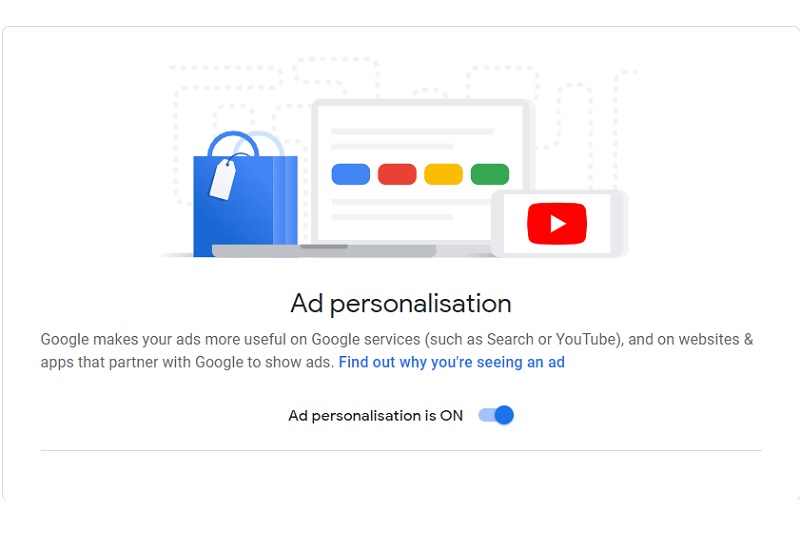Turn Off Google Ad Personalization and Learn What Data Shapes Your Ads
I recently discovered just how much information Google gathers about me by exploring the settings that Google itself exposes. The realization was eye-opening: there may be more data being collected than I initially imagined, and much of it feels highly informative. If you’re at all concerned about privacy, it’s worth examining your own settings to understand what gets collected and how it’s used. For years, conversations about Google Assistant and the Chrome browser have suggested that Google monitors activity, but the full extent of the data trail can be surprising. Many users will find themselves surprised by how integrated Google is with everyday online life, and how deeply it tailors ads based on that data. For some, this level of personalization can feel intrusive; for others, it improves relevance. Either way, awareness is the first step.
What Google Ad Personalization Uses
Google Ad Personalization operates on a triad of data sources that work in concert to shape the ads you see. The first pillar consists of personal information you actively add to your Google Account. This can include basic identifiers, profile details, and preferences that you have supplied directly to Google. The second pillar is data that Google gathers from advertisers who partner with Google. This means information advertisers collect about your interactions, purchases, and interests may be shared with Google and, in turn, used to refine ad delivery across Google’s ecosystem. The third pillar is Google’s own estimation of your interests based on your behavior across Google services and devices. This inferred profile is not merely a reflection of past actions; it’s a predictive construct designed to anticipate what you might find engaging or useful in the near future.
The combination of these data sources creates a dynamic model of your potential interests and needs. The personalization settings provide a framework for users to understand what factors contribute to ad targeting and how those factors influence the ads that appear across Google’s platforms. The fundamental idea is straightforward: the more Google knows about you, the better it can align advertising with your probable interests. However, this mechanism also means that seemingly minor interactions, such as a search query, a video watch, or even a site you visited, can feed into the system and subtly impact the ads that follow you online.
There is typically a central interface that presents these factors as discrete items you can review. Each item represents a data source or an inferred interest area. You can engage with these items to learn more about why a particular category is being used, or to adjust your preferences. A toggle switch is often provided to enable or disable personalization overall, and many individual items permit per-item activation or deactivation. In practice, this means you can granularly curate which elements contribute to ad personalization and which do not. When you select an item, a pop-up or a dedicated panel generally appears, offering options to turn it off or modify its settings. This design is meant to give users control without forcing a full opt-out, thereby balancing privacy with the desire for relevant advertising.
From a practical perspective, the Ad Personalization settings are not merely a passive display. They function as an active control panel for ongoing data collection and targeting. The settings live within the broader Google account controls, and they reflect current data flows from your interactions across Google services. While turning off an individual item can reduce personalization from that specific source, it does not guarantee that other data pathways won’t continue to inform ads in some fashion. The architecture is inherently interconnected: advertisers’ data, account-based information, and behavioral signals combine in complex ways to produce what you see in your feed, search results, and across the Google network.
In terms of user experience, the personalization model is designed to be informative and actionable. When you click on a specific item, you may be presented with a concise explanation of how that item influences ads and why it matters for your advertising experience. The system often invites you to adjust preferences, with clear options to turn off the item entirely. The underlying goal is to demystify the targeting logic and empower users to shape the advertising environment to their comfort level. For users who are deeply privacy-conscious, this can be a powerful feature, offering a path to reduce exposure in a targeted advertising ecosystem. For others who value relevance over privacy concerns, leaving settings as-is can sustain the current level of personalization, which may improve the relevance of ads and related content.
Beyond the account-centric data, it’s important to recognize that Google’s ad personalization happens within a broader advertising ecosystem. Advertisers leverage pixel data, device identifiers, and cross-device signals to build a more complete profile of user behavior. Google’s role is to orchestrate this information, applying machine learning models that continuously adapt to new data. Over time, patterns emerge that help predict what users will respond to, what products they might be inclined to explore, and which messages might resonate most. The practical effect for many users is a stream of advertisements that feel increasingly aligned with their interests, sometimes even before they explicitly express those interests in a search or interaction.
The overall takeaway is that Ad Personalization rests on a tripartite data foundation, with a feedback loop that refines targeting as more information is gathered. The presence of a per-item toggle and context-specific explanations is designed to promote transparency and user agency. Yet the reality is that this system is highly dynamic and continually evolving as new data arrives and models are retrained. The result is a personalized advertising experience that can be remarkably accurate in some cases, while in other scenarios might feel routine or even a bit invasive to those who value stricter privacy.
How Ads Are Personalised: The Mechanism Behind the Targeted Experience
To understand the practical implications of Google Ad Personalization, it helps to examine the mechanism that translates data into ads. At a high level, Google uses a combination of profile data, activity signals, and advertiser-provided information to assemble a probabilistic understanding of user interests. This understanding drives the delivery of ads that are more likely to resonate with a given user at a given moment. The process relies on sophisticated ranking and bidding algorithms, which consider a multitude of factors, including the user’s recent queries, their location, the device being used, time of day, and historical engagement patterns.
The ad delivery pipeline can be understood as a continuous cycle. First, a user generates signals through actions such as searches, page visits, video views, app usage, and other interactions within Google’s ecosystem. These signals add to the user’s profile, expanding both explicit data (what the user has directly provided) and implicit data (inferred preferences). Next, advertisers who participate in Google’s ecosystem provide data about their audiences and campaign objectives. This data is used to identify which users might be most receptive to a given ad and how to allocate impressions across different channels. Finally, Google applies machine learning models to rank available ads for the user, considering the likelihood of engagement, conversion, or other defined outcomes. The ads selected by the model are then shown to the user in various formats across Google’s services and properties.
What makes this system particularly intricate is the way it blends deterministic signals with probabilistic inferences. Deterministic signals arise from concrete inputs, such as a user’s stated interests, demographics, or declared preferences within the Google Account. Probabilistic signals, on the other hand, emerge from patterns learned by the models, based on large-scale data analytics across many users. The models are designed to predict outcomes like click-through rate, conversion likelihood, and product interest, then optimize ad selection accordingly. This predictive approach aims to maximize relevance for users while delivering value for advertisers. The net effect is a personalized advertising experience that can feel highly precise, especially when travel plans, shopping intents, or hobbies are consistently echoed across online activity.
Another key component is the cross-device and cross-service consistency that underpins personalization. Ads and related signals are tied to a user’s identity across devices. What you search on a desktop may influence what you see on a mobile device, and vice versa. This interconnectedness means that personalization isn’t limited to a single app or service, but rather spans the entire Google ecosystem, including YouTube, Google Search, the Google Display Network, and partner sites that rely on Google’s advertising infrastructure. The comprehensiveness of this data integration helps explain why ads can feel so aligned with a user’s interests, sometimes appearing in places you might not expect, like a video suggestion before you even realize you want a particular product.
From a user experience perspective, the result is a stream of tailored ads that can reduce information overload by presenting relevant options and recommendations. For some users, this can streamline decision-making and improve discovery. For others, it raises questions about how many touchpoints in a person’s online life are being tracked and how that data is used to influence choices. The balance between usefulness and privacy remains a central theme as people navigate the consequences of data collection and targeted advertising. The ad personalization mechanism is not simply a set of ad placements; it’s a complex system that continuously refines itself in response to user behavior and advertiser strategies.
Managing Your Ad Personalization: Review, Control, and Trade-offs
A central benefit of Google Ad Personalization is the ability to manage, review, and adjust the factors that influence ads. The interface typically offers a combination of global controls and item-specific settings. A user can choose to switch personalization on or off altogether, and then further refine by turning individual data sources on or off. This layered control is designed to give users options that range from broad to granular, depending on tolerance for privacy concerns and the desire for relevant ads.
To access these controls, you would typically navigate to your Google Account settings, find the Ad Personalization section, and review the various data sources and interest categories. Each item corresponds to a specific aspect of your data or inferred interest. Selecting an item may reveal a short explanation of why that item is used for ad targeting and what impact turning it off might have on ad relevance. When you click on an item, you may encounter a pop-up or a dedicated panel that contains the toggle to disable it or customize it further. The design aims to be intuitive: provide visibility into what’s being used and give you the power to opt out of individual components without losing the overall personalization framework entirely.
The practical implications of these controls are nuanced. Turning off a particular item can reduce the influence of that factor on your ads, but it does not guarantee a complete opt-out from targeted advertising. Other data points and inferences may continue to contribute to ad personalization, either directly or through cross-referencing with related signals. In other words, even with granular controls, a degree of personalization may persist due to the system’s interconnected nature and the ongoing collection of broader behavioral signals across Google’s ecosystem. This reality underlines a broader privacy principle: complete anonymity in a large digital advertising environment is difficult to achieve, and even extensive opt-out measures may leave residual personalization in place.
From a user perspective, there are trade-offs to consider. Some users value the enhanced relevance that personalization affords, including more useful ads and recommendations that align with their interests. For these users, keeping personalization enabled—at least in part—can feel like a net positive, as it reduces time spent sifting through unrelated content. Others may prioritize privacy above all and choose to reduce or disable data collection wherever possible. They might prefer incognito or private modes, the use of separate accounts for different activities, or even a shift toward services that emphasize minimal data collection. It’s important to acknowledge that even with significant controls, a broad privacy-preserving effect remains challenging in today’s digital advertising landscape because many platforms rely on data exchange and cross-service integration to sustain targeted advertising models.
For individuals who want to minimize data exposure, several practical steps can be taken within the Google ecosystem and beyond. First, review the Ad Personalization settings regularly, as the landscape of data sources and inferred interests can evolve with new features and services. Second, disable any items you consider sensitive or unnecessary for your personal or professional life. Third, be mindful that turning off personalized ads does not necessarily stop data collection altogether; you may still be subject to non-personalized ads or ads based on contextual factors such as the content you are viewing or the current search query. Fourth, consider broader privacy practices, such as limiting cross-site tracking, adjusting permissions on connected devices, and evaluating app permissions that can feed data into advertising networks. These steps can collectively reduce the amount of data available for ad personalization while preserving the functional benefits of Google services.
It’s also important to be realistic about the feasibility of complete privacy. The digital advertising ecosystem is built on data exchange and collaboration among countless partners, and data is often aggregated in ways that can be difficult to fully control. Many users find themselves in a situation where privacy and personalization are in tension, and the decision to live with targeted ads or pursue more aggressive privacy measures is a personal one. The goal of user controls is to empower informed choices, not to deliver an all-or-nothing mandate. By engaging with the settings and understanding the sources of data, users can tailor their experience to reflect their preferences while maintaining access to the tools and services that rely on data-driven personalization.
Personal Experience, Perceptions, and the Broader Privacy Landscape
From a personal perspective, the decision about whether to deactivate ad personalization is nuanced. The author of the original reflections notes a preference for maintaining targeted ads over random, less relevant advertising. This stance highlights a broader trade-off: targeted ads can be more useful and time-efficient, potentially leading to better product discovery and informed purchasing choices. Yet such a preference does not negate concerns about privacy. The degree to which one is comfortable with data collection varies widely among individuals and life contexts. Some people may tolerate higher levels of data sharing in exchange for conveniences and improvements in service, while others insist on stricter boundaries and opt for privacy-centric configurations or more conservative usage patterns.
The broader ecosystem beyond Google also contributes to the data that powers targeted ads. Google is not alone in collecting user data and deploying ad personalization strategies. A wide range of digital platforms, websites, and services gather data through diverse mechanisms, including cookies, device identifiers, search histories, social interactions, and cross-service integrations. The cumulative effect is a pervasive data trail that advertisers can leverage across multiple channels. This reality points to a fundamental challenge: achieving comprehensive privacy in a deeply connected digital environment requires coordinated action, consistent practices across platforms, and meaningful user-centric controls. For many users, the practical takeaway is not a definitive solution but a set of best practices and informed choices that help balance privacy with the benefits of tailored content and advertising.
In practice, some readers may feel that opting out of personalization is a step toward reclaiming privacy, while others may conclude that the effort yields limited return, given the pervasiveness of data collection and cross-platform tracking. The conversation often includes considerations about the effectiveness of privacy tools, the potential for data minimization, and the ethical dimensions of targeted advertising. The reality is that total invisibility is difficult to achieve in the modern online landscape; however, improving transparency and giving users precise, actionable controls remains a meaningful objective. The ongoing debate focuses on how to preserve the advantages of personalized services and targeted advertising while ensuring that individuals have robust, understandable, and practical options to protect their privacy.
From a broader societal standpoint, the story underscores the need for ongoing dialogue about data governance, user rights, and the responsibilities of major tech platforms. While individual actions—such as reviewing ad personalization settings and turning off specific data sources—are valuable, long-term privacy protection may require structural changes in how data is collected, stored, and used. This includes clear consent mechanisms, rigorous data minimization, transparent data retention policies, and robust safeguards against misuse. As users navigate these issues, the balance between privacy, innovation, and economic models will continue to shape the digital advertising landscape for years to come.
The Industry Context: What This Means Beyond Google
The questions raised by Google Ad Personalization extend beyond a single platform. Many online services collect, store, and process data in ways that enable tailored advertising and personalized experiences. The impression left by the Google settings is that a highly interconnected set of data sources can converge to form a precise portrait of a user’s interests. This is consistent with broader industry practices where data from multiple touchpoints—search activity, video consumption, location signals, app usage, and even offline data provided by advertisers—can be merged to create a richer, more actionable profile for targeted advertising.
The implications for consumers are twofold. On one hand, enhanced personalization can lead to more relevant content, product recommendations, and promotional offers. On the other hand, it increases the risk of overexposure, erosion of privacy, and a sense of being constantly watched. This duality has spurred ongoing debates among policymakers, privacy advocates, industry players, and everyday users about how to strike a fair balance. The outcome of these debates will influence the design of future privacy controls, consent frameworks, and the transparency consumers receive about how their data is used.
From a technical standpoint, the industry continues to refine methods for data collection and analysis that are faster, more accurate, and capable of operating at scale. The rise of machine learning, artificial intelligence, and real-time bidding fuels a cycle of rapid improvement in ad personalization. Yet with these advances come concerns about fairness, bias, and the potential for discriminatory targeting. Regulators and practitioners alike are paying closer attention to issues such as data provenance, consent adequacy, and user autonomy. The challenges are complex, but the push toward more explicit user controls, clearer explanations of data usage, and opt-out options remains a key focus for responsible privacy practices.
For readers who want to take action, the takeaway is clear: familiarize yourself with the ad personalization tools available across major platforms, periodically audit your data exposure, and consider adopting privacy-preserving practices when appropriate. This approach is not about eliminating all targeted advertising but about reclaiming agency over one’s digital footprint. It’s about ensuring that the data being used to shape ads and recommendations aligns with personal preferences and comfort levels. In that sense, the Google Ad Personalization settings serve as a microcosm of the larger privacy conversation unfolding across the digital advertising industry.
The Path Forward: Privacy, Regulation, and User Empowerment
Looking ahead, several forces will shape how ad personalization and privacy evolve. First, user empowerment remains central. Providing clear, accessible controls that enable users to understand and manage data collection is critical. The ability to review data sources, adjust preferences, and opt out of specific data signals should become a standard feature across digital platforms, not an exception. Second, transparency must improve. Users need to know exactly what data is being collected, how it’s used, and what the practical consequences are of turning particular items on or off. Clear explanations, not opaque labels, will help users make informed decisions about privacy and personalization. Third, regulators and industry groups will continue to push for standards that protect user rights while supporting innovation and the business models that rely on data-driven advertising. Compliance frameworks, consent requirements, and robust data protection mechanisms will play central roles in shaping platform design and user experience.
Fourth, privacy-preserving technologies may offer alternative pathways for advertisers and platforms. Techniques such as differential privacy, on-device processing, and aggregated, anonymized data analysis aim to balance personalization with strong privacy protections. While these approaches are technically complex and may not eliminate targeted advertising entirely, they can reduce the amount of personal data that needs to be exposed or transferred. The industry’s ability to adopt and implement these technologies will influence how user privacy evolves in practice. Finally, user expectations will continue to evolve. As more people become aware of how data is used to personalize ads, demand for greater control, easier opt-out mechanisms, and more transparent explanations will grow. Platforms that respond to these expectations with practical, reliable privacy features are likely to gain trust and maintain competitiveness in a crowded digital landscape.
In sum, the Google Ad Personalization experience reflects broader themes in digital privacy and advertising. It illustrates a system that relies on a mixture of explicit data, inferred interests, and advertiser-provided signals to deliver targeted content. It also demonstrates that users have meaningful, if sometimes nuanced, control over how their data influences advertising outcomes. The ongoing challenge is to maintain a balance that respects privacy while preserving the benefits of personalized experiences. As the industry progresses, the emphasis should be on empowering users with clearer choices, meaningful transparency, and practical protections that align with evolving norms, regulations, and technologies.
Conclusion
The exploration of Google Ad Personalization settings reveals a landscape where the quantity and variety of data used for targeting ads are more expansive than many users anticipate. Personal information stored in Google Accounts, combined with data from advertisers and Google’s own interpretations of user interests, creates a comprehensive framework for ad delivery. The ability to toggle personalization on or off and to disable individual data points provides a mechanism for user control, though it may not completely remove all personalization due to the interconnected nature of the advertising ecosystem. This reality underscores the importance of regularly reviewing privacy controls, understanding what data is collected, and recognizing the trade-offs between privacy and personalization.
From a broader perspective, these insights reflect a wider trend across the digital advertising industry: data-driven personalization is driven by complex data networks that span multiple platforms and services. While targeted ads can offer practical value by delivering more relevant content and offers, they also raise legitimate concerns about privacy, consent, and data ownership. The path forward involves a combination of user empowerment, clearer explanations, stronger protections, and ongoing innovation in privacy-preserving technologies. As users become more informed and as regulations evolve, the balance between useful personalization and robust privacy will continue to shape the design of future online experiences.



